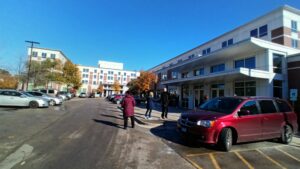 What do the words Harbor Light, Hope, and Freedom mean to you? This was one of the first questions Captain Elis Pomales Morales asked our Front Line Mission Tour group during a Fall 2023 trip to the Harbor Light Freedom Center located in Chicago’s West Humboldt Park neighborhood. I was one of nine employees from The Salvation Army Central Territorial Headquarters to take advantage of the opportunity to visit two of the most modern and impactful facilities in the Central Territory.
What do the words Harbor Light, Hope, and Freedom mean to you? This was one of the first questions Captain Elis Pomales Morales asked our Front Line Mission Tour group during a Fall 2023 trip to the Harbor Light Freedom Center located in Chicago’s West Humboldt Park neighborhood. I was one of nine employees from The Salvation Army Central Territorial Headquarters to take advantage of the opportunity to visit two of the most modern and impactful facilities in the Central Territory.
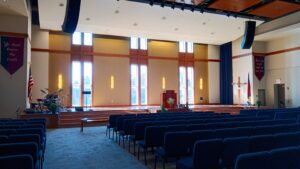 After introductions our tour began in the Chicago (Harbor Light), IL Corps’ chapel. Sunlight poured in through tall windows behind the chancel in the spacious and peaceful worship hall. Flanking the chancel were two banners quoting the passage, “Ye shall know the truth, And the truth shall set you free.” These words were quite meaningful to me as I would later reflect on our visit. Captain Elis welcomed us and described the chapel and facility as “Mi casa es su casa” (My house is your house). He then told us about the day in 2008 in Iowa City when former Bandmaster William “Bill” Himes affectionately gave him the nickname “Troublemaker.” Captain Elis had joined in, uninvited, on guitar on one his favorite songs, Make Me a Channel of Your Peace. Bill jokingly told him he did a great job, but to never do it again. Years later, Bill recognized the “Troublemaker” and warmly told him how one’s actions can deeply affect each person you interact with.
After introductions our tour began in the Chicago (Harbor Light), IL Corps’ chapel. Sunlight poured in through tall windows behind the chancel in the spacious and peaceful worship hall. Flanking the chancel were two banners quoting the passage, “Ye shall know the truth, And the truth shall set you free.” These words were quite meaningful to me as I would later reflect on our visit. Captain Elis welcomed us and described the chapel and facility as “Mi casa es su casa” (My house is your house). He then told us about the day in 2008 in Iowa City when former Bandmaster William “Bill” Himes affectionately gave him the nickname “Troublemaker.” Captain Elis had joined in, uninvited, on guitar on one his favorite songs, Make Me a Channel of Your Peace. Bill jokingly told him he did a great job, but to never do it again. Years later, Bill recognized the “Troublemaker” and warmly told him how one’s actions can deeply affect each person you interact with.
Our tour was filled with many stor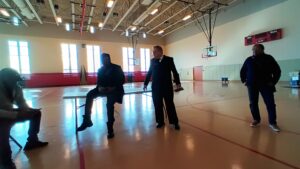 ies of how the selfless actions of Salvation Army staff and volunteers had affected others in positive ways. Our next stop was in the gymnasium where Captain Elis and Youth Programs Coordinator, Lorenzo Fishback, told us about Sunday Fundays, after-school programs, and other activities that are a much-needed respite for the youth in the community.
ies of how the selfless actions of Salvation Army staff and volunteers had affected others in positive ways. Our next stop was in the gymnasium where Captain Elis and Youth Programs Coordinator, Lorenzo Fishback, told us about Sunday Fundays, after-school programs, and other activities that are a much-needed respite for the youth in the community.
 We continued down the hall where we met Captain Elis’ wife, Captain Ada Diaz-Fajardo. Earlier, he had proclaimed that Chicago (Harbor Light) “is a place where many souls have been saved.” Many souls were served as well as saved. While showing us the food pantry, Captains Ada and Elis told us that thirty thousand meals were distributed during the previous month. The kitchen prepares meals for the Freedom Center, as well as the Chicago (Harbor Light), Shield of Hope, and Pathway Forward (formerly correctional services) facilities.
We continued down the hall where we met Captain Elis’ wife, Captain Ada Diaz-Fajardo. Earlier, he had proclaimed that Chicago (Harbor Light) “is a place where many souls have been saved.” Many souls were served as well as saved. While showing us the food pantry, Captains Ada and Elis told us that thirty thousand meals were distributed during the previous month. The kitchen prepares meals for the Freedom Center, as well as the Chicago (Harbor Light), Shield of Hope, and Pathway Forward (formerly correctional services) facilities.
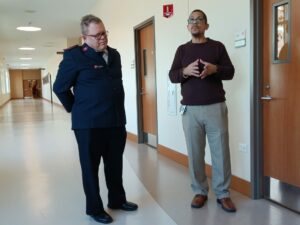 The group then headed down a long hallway toward the Harbor Light Center and stopped to talk to Alex Garcia, Employment Service Manager. He described his job duties, but also told a story of heeding the call to go the extra mile to help a beneficiary who went from homeless to having a job and his own apartment. These basic things are part of most of our daily lives and we take that for granted.
The group then headed down a long hallway toward the Harbor Light Center and stopped to talk to Alex Garcia, Employment Service Manager. He described his job duties, but also told a story of heeding the call to go the extra mile to help a beneficiary who went from homeless to having a job and his own apartment. These basic things are part of most of our daily lives and we take that for granted.
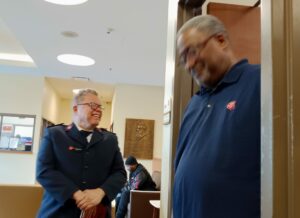 Just past the end of the hallway we met Mark Thompson, Resident Manager, of the Harbor Light Center who gave us firsthand knowledge of how addiction can take away those basic things very quickly. Mark went through the recovery process at the Center’s old location at 1515 West Monroe Street thirteen times before he turned the corner. Thirteen years later he helps manage this four-story 280 bed rehabilitation facility that opened in 2015. Near Mark’s office is the lobby and reception desk for Pathway Forward, a joint Salvation Army and federal facility that helps formerly incarcerated men and women successfully re-enter society.
Just past the end of the hallway we met Mark Thompson, Resident Manager, of the Harbor Light Center who gave us firsthand knowledge of how addiction can take away those basic things very quickly. Mark went through the recovery process at the Center’s old location at 1515 West Monroe Street thirteen times before he turned the corner. Thirteen years later he helps manage this four-story 280 bed rehabilitation facility that opened in 2015. Near Mark’s office is the lobby and reception desk for Pathway Forward, a joint Salvation Army and federal facility that helps formerly incarcerated men and women successfully re-enter society.
“Relapse is part of recovery” – Mark Thompson
On the way to the elevators to Harbor Light’s upper floors I noticed a sign on the wall that proclaimed, “All are Welcome Here! And we mean Everybody!” It might as well have been written in stone. I’d heard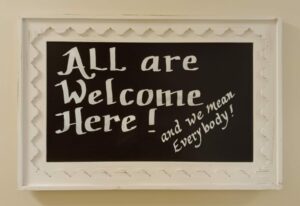 more than one staff member say that during our visit. Upstairs we were joined by Leon Denton, Divisional Social Services Director, Chicago Social Services. He and Captain Elis showed us two of the unoccupied bedrooms as they explained the different levels of rehabilitation and care at the Center. We greeted several of the beneficiaries in the hallways. Captain Elis reminded one of the men he knew that recovery is a process by saying, “one day at a time, right.” When we got back down to the first floor Leon conveyed a difficult fact that addiction can wreak havoc on a person’s life, “it’s very hard when your family doesn’t want you, we don’t throw you away,” echoing a staff member’s creed “treatment for everybody.”
more than one staff member say that during our visit. Upstairs we were joined by Leon Denton, Divisional Social Services Director, Chicago Social Services. He and Captain Elis showed us two of the unoccupied bedrooms as they explained the different levels of rehabilitation and care at the Center. We greeted several of the beneficiaries in the hallways. Captain Elis reminded one of the men he knew that recovery is a process by saying, “one day at a time, right.” When we got back down to the first floor Leon conveyed a difficult fact that addiction can wreak havoc on a person’s life, “it’s very hard when your family doesn’t want you, we don’t throw you away,” echoing a staff member’s creed “treatment for everybody.”
We then had lunch with Leon, Captains Elis and Ada, Captains Corey and Nikki Hughes, and Envoy Tyrone Staggers. They told us how the Freedom Center overcame the challenge of providing for the recent influx of Venezuelan migrants. “It was triage in the chapel,” Captain Corey explained. It wasn’t just the amount of people but things like communication; at the time, no one on the staff spoke Spanish. I was moved when I heard that two of the Venezuelan men narrowly escaped a human trafficking scheme. They jumped out of a moving vehicle when they realized what was happening and then called the staff for a ride back to the Freedom Center.
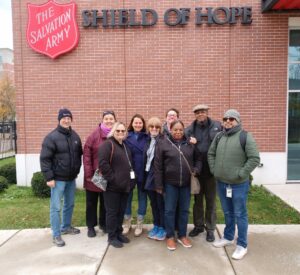 After lunch, Leon took us for a tour of the Shield of Hope facility. Dedicated on March 6, 2018, this one-of-a-kind operation is the nation’s first emergency homeless assessment and rapid-response center (EHARC) created by any organization. We entered the lobby. On the left were children playing while two women sat and filled out forms. The wall to our right was decorated with “Family is…” and photos of staff members in frames labeled sweet, joy, wonderful and togetherness. Leon described how, as a part of the 311-telephone emergency system, the facility works closely with the City of Chicago to provide temporary shelter, food, and sometimes protection for families and some individuals.
After lunch, Leon took us for a tour of the Shield of Hope facility. Dedicated on March 6, 2018, this one-of-a-kind operation is the nation’s first emergency homeless assessment and rapid-response center (EHARC) created by any organization. We entered the lobby. On the left were children playing while two women sat and filled out forms. The wall to our right was decorated with “Family is…” and photos of staff members in frames labeled sweet, joy, wonderful and togetherness. Leon described how, as a part of the 311-telephone emergency system, the facility works closely with the City of Chicago to provide temporary shelter, food, and sometimes protection for families and some individuals.
During our tour of the kitchen, hot dogs were prepared for a family in transition. Staff wanted to be sure they ate since displaced families can never be sure where their next meal will come from. Because of the success of this Shield of Hope, Chicago officials have expressed interest in opening a second Shield of Hope at another location in the city. Leon pointed out features not normally found in shelters, such as adjoining rooms for larger families and accessibility for people with challenges. In addition to helping Chicago residents in need, Leon recalled how the building temporarily served as a shelter for the Venezuelan migrants. He spoke of how the refugee families chose to stay in rooms together for safety and comfort even though they could have stayed in larger suites with adjoining rooms. We then headed down to the lobby and said our goodbyes, thanking Leon for the opportunity to visit and learn about the Shield of Hope.
I am the Registrar at the Salvation Army Central Territory Museum. Working in a comfortable office building in the Chicago suburbs, I see photographs, documents, and artifacts that represent past and present events, programs and achievements by Salvation Army officers, soldiers, and adherents. This Front Line Mission Tour gave me the opportunity to see more than just photographs. I was able to see the incredible amount of good work the Salvation Army does every single day, not just in Chicago or the Central Territory, but throughout the country and around the world.
Most of the people on our tour had their own unique definitions of Harbor Light, Hope, and Freedom. I didn’t have an answer at the time but while writing this article I read the passages on the banners in the Chicago (Harbor Light) chapel and thought of Jesus’ message “I am the way and the truth and the life.” Jesus provided light, hope, freedom, and truth to all. Today that would include addicts, migrants, ex-convicts, children, families, registrars and “Troublemakers.”
“All are welcome here! And we mean everybody!”
Feature Image: Left to Right: Captain Elis Pomales-Morales, Captain Ada Diaz Fajardo, Envoy Tyrone Staggers, Captains Corey and Nikki Hughes.
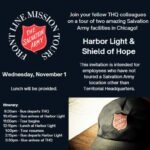
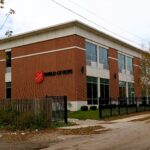

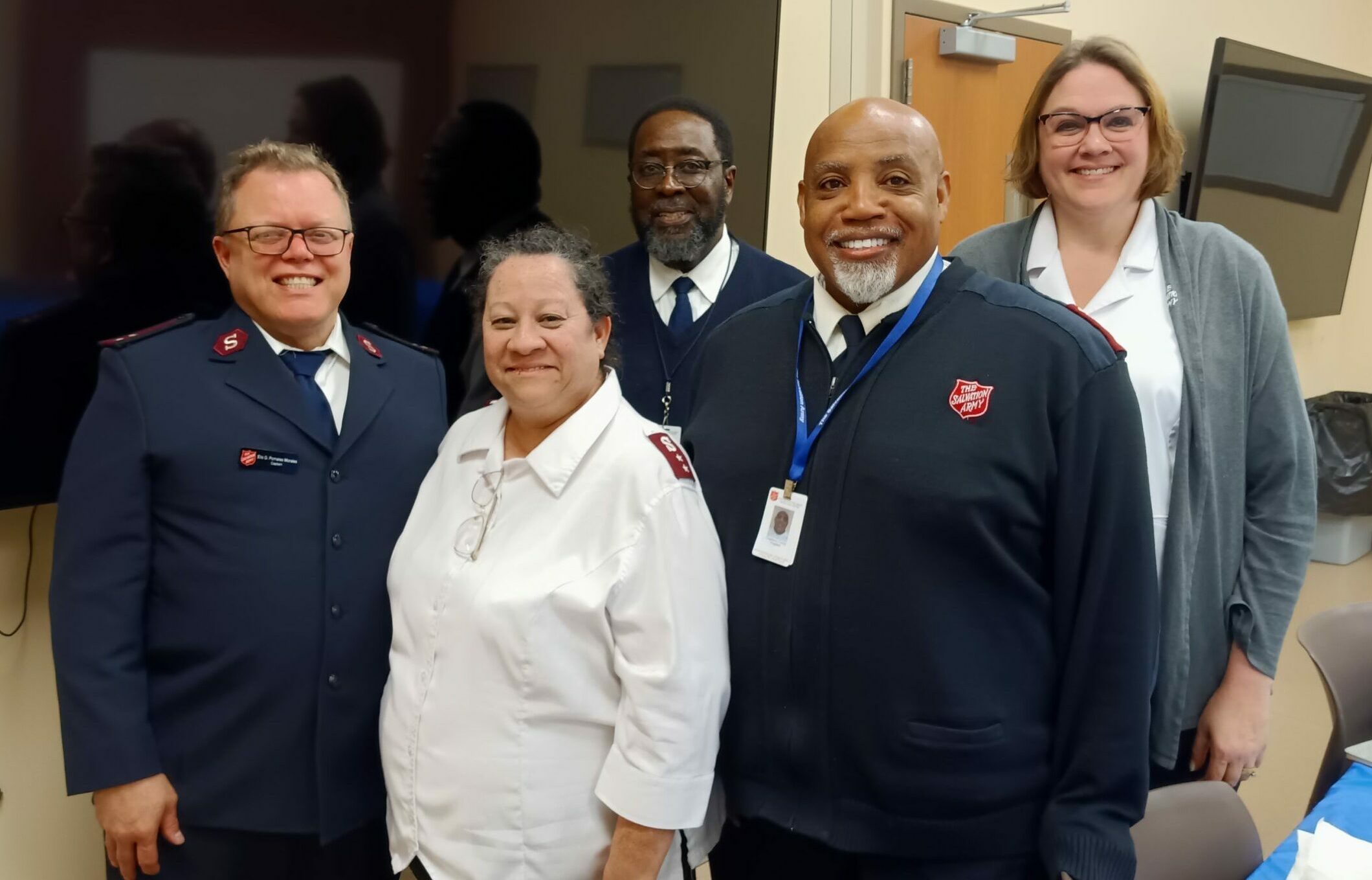
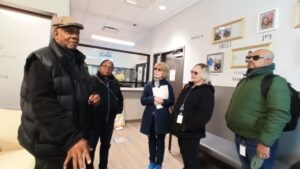
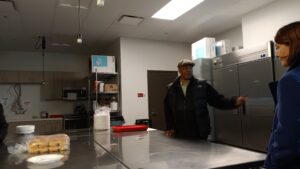
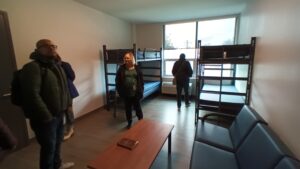
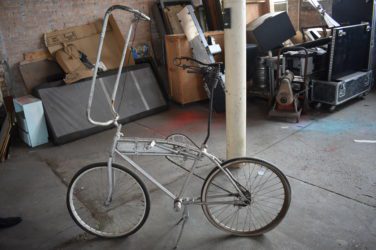
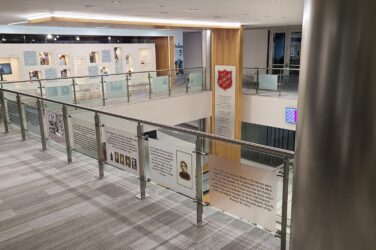
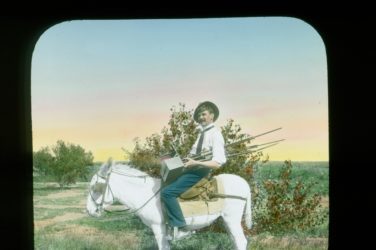

Show Comments